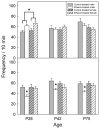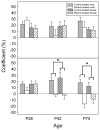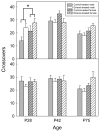Acute prenatal exposure to ethanol and social behavior: effects of age, sex, and timing of exposure
- PMID: 20728475
- PMCID: PMC2975787
- DOI: 10.1016/j.bbr.2010.08.014
Acute prenatal exposure to ethanol and social behavior: effects of age, sex, and timing of exposure
Abstract
During development of the central nervous system, neurons pass through critical periods of vulnerability to environmental factors. Exposure to ethanol during gastrulation or during neuronal generation results in a permanent reduction in the number of neurons in trigeminal-associated cranial nerve nuclei. Normal functioning of the trigeminal system is required for social behavior, the present study examined the effects of acute prenatal exposure to ethanol on social interactions across ontogeny. Pregnant Long-Evans rats were injected with 2.9 g/kg ethanol (i.p., 20%, v/v solution; peak blood ethanol concentrations of ∼300 mg/dl) or an equivalent volume of saline on gestational day (G) 7 (gastrulation) or G12 (neuronal generation). Subsequently, social investigation, play fighting, contact behavior, social motivation, and overall locomotor activity in the social context were assessed in male and female off-spring during early adolescence, late adolescence, or adulthood, on postnatal day (P) 28, P42, or P75, respectively, using a modified social interaction test. Ethanol exposure on G7 resulted in mild changes of social behavior evident in young adolescents only. In contrast, animals exposed to ethanol on G12 demonstrated pronounced behavioral deficits throughout ontogeny, with deficits being most robust in male off-spring. Males exposed to ethanol on G12 showed decreases in social investigation, contact behavior, and play fighting, whereas a decrease in social motivation, i.e., transformation of social preference into social avoidance, was evident at P42 and P75 regardless of sex. These findings show that acute exposure to ethanol alters social behavior, and that the timing of the exposure defines the behavioral outcome.
Copyright © 2010 Elsevier B.V. All rights reserved.
Figures





Similar articles
-
Acute exposure to ethanol on gestational day 15 affects social motivation of female offspring.Behav Brain Res. 2014 Mar 15;261:106-9. doi: 10.1016/j.bbr.2013.12.016. Epub 2013 Dec 16. Behav Brain Res. 2014. PMID: 24355753 Free PMC article.
-
Molecular substrates of social avoidance seen following prenatal ethanol exposure and its reversal by social enrichment.Dev Neurosci. 2012;34(2-3):115-28. doi: 10.1159/000337858. Epub 2012 May 8. Dev Neurosci. 2012. PMID: 22572756 Free PMC article.
-
Acute prenatal exposure to ethanol on gestational day 12 elicits opposing deficits in social behaviors and anxiety-like behaviors in Sprague Dawley rats.Behav Brain Res. 2016 Sep 1;310:11-9. doi: 10.1016/j.bbr.2016.05.003. Epub 2016 May 3. Behav Brain Res. 2016. PMID: 27154534 Free PMC article.
-
Adolescent alcohol exposure: Are there separable vulnerable periods within adolescence?Physiol Behav. 2015 Sep 1;148:122-30. doi: 10.1016/j.physbeh.2015.01.027. Epub 2015 Jan 23. Physiol Behav. 2015. PMID: 25624108 Free PMC article. Review.
-
Social consequences of ethanol: Impact of age, stress, and prior history of ethanol exposure.Physiol Behav. 2015 Sep 1;148:145-50. doi: 10.1016/j.physbeh.2014.11.062. Epub 2014 Nov 26. Physiol Behav. 2015. PMID: 25431835 Free PMC article. Review.
Cited by
-
Primary cilia safeguard cortical neurons in neonatal mouse forebrain from environmental stress-induced dendritic degeneration.Proc Natl Acad Sci U S A. 2021 Jan 5;118(1):e2012482118. doi: 10.1073/pnas.2012482118. Epub 2020 Dec 21. Proc Natl Acad Sci U S A. 2021. PMID: 33443207 Free PMC article.
-
Detection of prenatal alcohol exposure using machine learning classification of resting-state functional network connectivity data.Alcohol. 2021 Jun;93:25-34. doi: 10.1016/j.alcohol.2021.03.001. Epub 2021 Mar 11. Alcohol. 2021. PMID: 33716098 Free PMC article.
-
Social Interaction in Adolescent Rats with Neonatal Ethanol Exposure: Impact of Sex and CE-123, a Selective Dopamine Reuptake Inhibitor.Int J Mol Sci. 2024 Jan 15;25(2):1041. doi: 10.3390/ijms25021041. Int J Mol Sci. 2024. PMID: 38256113 Free PMC article.
-
Is alcohol binge drinking in early and late pregnancy associated with behavioural and emotional development at age 7 years?Eur Child Adolesc Psychiatry. 2014 Dec;23(12):1175-80. doi: 10.1007/s00787-013-0511-x. Epub 2014 Jan 5. Eur Child Adolesc Psychiatry. 2014. PMID: 24390718
-
Altered activity within the social behavior neural network in adolescent rats following prenatal alcohol exposure and/or early-life adversity.Alcohol Clin Exp Res (Hoboken). 2025 Jul;49(7):1445-1458. doi: 10.1111/acer.70082. Epub 2025 May 20. Alcohol Clin Exp Res (Hoboken). 2025. PMID: 40395053 Free PMC article.
References
-
- Altman J. Autoradiographic and histological studies of postnatal neurogenesis. IV. Cell proliferation and migration in the anterior forebrain, with special reference to persisting neurogenesis in the olfactory bulb. J Comp Neurol. 1969;137:433–457. - PubMed
-
- Bayer SA. 3H-thymidine-radiographic studies of neurogenesis in the rat olfactory bulb. Exp Brain Res. 1983;50:329–340. - PubMed
-
- Bayer SA, Altman J. Neocortical Development. Raven Press; New York: 1991.
-
- Blanchard RJ, Blanchard DC. Aggressive behavior in the rat. Behav Biol. 1977;21:197–224. - PubMed
Publication types
MeSH terms
Substances
Grants and funding
LinkOut - more resources
Full Text Sources
Research Materials

